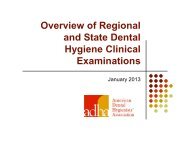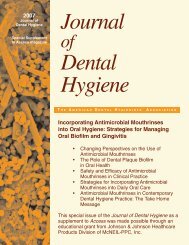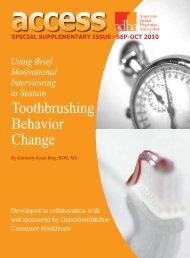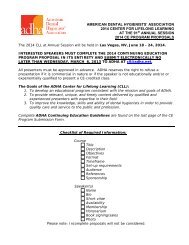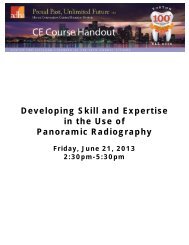Relationship Between Oral Health and Systemic Disease - American ...
Relationship Between Oral Health and Systemic Disease - American ...
Relationship Between Oral Health and Systemic Disease - American ...
Create successful ePaper yourself
Turn your PDF publications into a flip-book with our unique Google optimized e-Paper software.
contentsAbstract . . . . . . . . . . . . . 1The InflammatoryProcess . . . . . . . . . . . . . . 1Inflammation &<strong>Oral</strong> <strong>Health</strong>. . . . . . . . . . . 2The <strong>Oral</strong>-<strong>Systemic</strong><strong>Relationship</strong> . . . . . . . . . . 3Translating Scienceto Practice . . . . . . . . . . . 5Conclusion. . . . . . . . . . . 6A Case in Point . . . . . . . 7AbstractSince the mid 1990s, both the scientific community <strong>and</strong> thepublic have been inundated with articles addressing the associationbetween systemic diseases <strong>and</strong> oral health. It seems that almostmonthly there is an article in a fashion magazine reminding thepublic that tooth brushing <strong>and</strong> flossing can save their life. Somearticles point to the notion thatoral infection <strong>and</strong> bacteria maybe linked to heart attack <strong>and</strong>stroke. Others dispel the association,indicating that there is notenough research to determineany relationship between thetwo. The questions that havebeen raised focusing on the relationshipbetween periodontaldiseases <strong>and</strong> systemic conditionsnow extend beyond cardiovasculardisease <strong>and</strong> include diabetes,respiratory disease <strong>and</strong> adversepregnancy outcomes. ResearchResearch hasdemonstrated that theassociation between oralinflammation <strong>and</strong>systemic inflammationmay be the key tounderst<strong>and</strong>ing thedeleterious effects onmultiple organ systems.has demonstrated that the association between oral inflammation<strong>and</strong> systemic inflammation may be the key to underst<strong>and</strong>ing thedeleterious effects on multiple organ systems. However, is the relationshipso complex that it is like trying to crack the DaVinciCode, or can health care professionals <strong>and</strong> the public underst<strong>and</strong>the role of inflammation in oral <strong>and</strong> systemic health?The purpose of this article is to review how the inflammatoryprocess functions in the human body. The role of inflammation inoral <strong>and</strong> systemic health will be discussed. Translating this informationinto practical application for dental hygiene professionals willbe addressed so that both inquiring patients <strong>and</strong> astute clinicianswill capitalize on the opportunities for improving total health.The Inflammatory ProcessReferences. . . . . . . . . . . 8JoAnn R. Gurenlian, RDH, PhD, is the owner ofGurenlian & Associates. She provides consulting<strong>and</strong> continuing education programs for healthcare providers. She has experience in general,periodontic, pediatric <strong>and</strong> orthodontic practices,<strong>and</strong> works part-time in a medical practice.She is an internationally recognized speakeron the topics of oral pathology, oral medicine,diabetes, <strong>and</strong> women's health. Dr.Gurenlian volunteers with local cancer, health<strong>and</strong> political organizations.Clinical cover image courtesy of Dr. R<strong>and</strong>y Valentine,www.gumsbleeding.com.What is inflammation? Isn’t this the process that is supposedto be good for our bodies? How can it now be something that causesharm to so many different aspects of the body? As we learn moreabout the biological mechanisms of inflammation, it becomes clearthat this process is more complicated than was once thought.Inflammation is the body’s response to cellular injury. Despitethe fact that the press has emphasized the harmful effects of inflammation,the fact remains that without this process, our bodiescould not survive. Inflammation represents a protective responsedesigned to rid the body of the initial cause of cell injury <strong>and</strong> theconsequences of that injury. Cell injury may occur due to trauma,genetic defects, physical <strong>and</strong> chemical agents, tissue necrosis, foreignbodies, immune reactions <strong>and</strong> infections.Inflammation is a local reactive change that involves therelease of antibacterial agents from nearby cells that defend the hostagainst infection. It also facilitates early tissue healing <strong>and</strong> repair. Itcontains—or “walls off”—the infectious or injurious agent <strong>and</strong>serves as a defense mechanism that the body can use to restore itselfto a normal morphological form <strong>and</strong> function.special supplemental issue—april 2006—access 1






